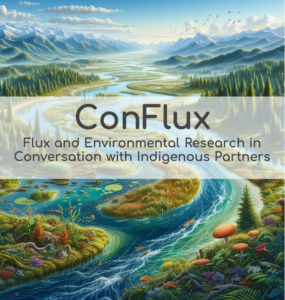Welcome to the page on all things AMP Webinar. The AmeriFlux Management Project (AMP) series focuses on sharing a wide range of information relevant to the AmeriFlux community (e.g., website updates, tutorials on accessing AmeriFlux data, etc.). We want to provide helpful tools for flux scientists, every step of the way – from generating flux data to using them in cool science!
The AmeriFlux Management Project team designed its webinar series in response to the impacts of COVID-19 on AmeriFlux work and operations, out of a desire to strengthen information sharing between the AMP project team and members of the AmeriFlux community. While this series focuses on practical tutorials, also keep an eye on the associated science seminar series that we are co-sponsoring with the FLUXNET Early Career Network!
Our webinars are open to all, access is free, and registration is required. We will use virtual meeting software zoom for live webinars and provide links to recordings after the event. You don’t need to install zoom or have an account. Find out how to run it from a browser here.
Contact AMP-Webinars@lbl.gov with any questions.
AMP Webinars
2024 webinars:
ConFlux Webinar Series: Flux and Environmental Research in Conversation with Indigenous Partners
July 22, 1PM EDT/10AM PDT: Ryan Emanuel, Duke University: “Environmental Justice for Environmental Science”
Ryan Emanuel studies ecohydrology, biogeosciences, environmental justice, and Indigenous rights, and aims to amplify voices of Indigenous and other marginalized communities who shoulder disproportionate environmental burdens. He is the author of On the Swamp – Fighting for Indigenous Environmental Justice
August 19, 1 PM EDT/10AM PDT: Angela Waupochick, University of Wisconsin – Madison: “Considerations for Tribal Engagement”
Angela Waupochick studies black ash conservation in forest wetlands in the Menominee and Stockbridge-Munsee Tribal Lands.
AmeriFlux “Luminaries” Webinar (TBD)
- Speaker: David Schimel (NASA JPL)
- Topic: TBD
AmeriFlux “Luminaries” Webinar (September 20)
- Speaker: Prasad Thenkabail & Padhasaradhi Teluguntla (USGS)
- Topic: Global croplands for water and food security in the twenty-first century
AmeriFlux “Luminaries” Webinar (June 14) (watch here)
- Speaker: John Gamon (University of Nebraska-Lincoln)
- Topic: Linking Remote Sensing and Flux Measurements to Assess Vegetation Functional Diversity in Space and Time
AmeriFlux “Luminaries” Webinar (May 24) (watch here)
- Speaker: Bill Kustas (USDA ARS)
- Topic: Quantifying Surface Energy Balance and Evapotranspiration from Field to Global Scales Using Remotely Sensed Land Surface Temperature
Orientation and Onboarding for new AmeriFlux sites (watch here)
This is an informal check-in with people who have started/registered new sites or who would like to see what is new. Join us to welcome new network members and learn what is new for site support.
2023 webinars:
Year of Remote Sensing Webinar (September 15) (watch here)
- Topic: LiDAR remote sensing to inform vegetation structure and its role in ecology
- Speaker: Martin Béland (Laval University) & Xi Yang (University of Virginia)
Year of Remote Sensing Webinar (July 27) (watch here)
- Topic: Link between flux and optical measurements
- Speaker: Youngryel Ryu (Seoul National University) & Kanishka Mallick (Luxembourg Institute of Science and Technology)
Year of Remote Sensing Webinar (June 9) (Sorry, video is not available due to a technical issue)
- Topic: Thermal remote sensing
- Speaker: Mallory Barnes (Indiana University Bloomington) & Madeleine Pascolini-Campbell (NASA Jet Propulsion Laboratory)
Year of Remote Sensing Webinar (May 17) (watch here)
- Topic: Solar-induced chlorophyll fluorescence
- Speaker: Lianhong Gu (Oak Ridge National Laboratory) & Christian Frankenberg (Caltech, Jet Propulsion Laboratory)
Year of Remote Sensing Webinar (April 21) (watch here)
- Topic: In the beginning… there was FLUXNET and MODIS
- Speaker: Steven Running (University of Montana)
Speaking UP Workshop (April 20)
Year of Remote Sensing Tutorial Series #3 (in 2 parts, March 10 & 17) (watch Part 1 & Part 2)
- The Tutorial Series is designed to introduce theories and techniques related to remote sensing tailored to the flux community.
- Topic: Analyzing flux and remote sensing data
- Speakers:
- Gilberto Pastorello (Lawrence Berkeley National Laboratory)
- Nicola Falco (Lawrence Berkeley National Laboratory)
Year of Remote Sensing Tutorial Series #2 (February 3) (watch here)
- The Tutorial Series is designed to introduce theories and techniques related to remote sensing tailored to the flux community.
- Topic: Introduction to remote sensing data acquisition tools
- Speakers:
- Xian Wang (Indiana University Bloomington)
- Carlos Wang (University of California Berkeley)
- Huiqi Wang (University of California Berkeley)
Year of Remote Sensing Tutorial Series #1 (January 11) (watch here)
- The Tutorial Series is designed to introduce theories and techniques related to remote sensing tailored to the flux community.
- Topic: Theory of remote sensing as it applies to fluxes
- Speakers:
- Josh Fisher (Chapman University)
- Troy Mangey (University of California Davis)
- Zoe Pierrat (University of California Los Angeles)
All 2022 webinars:
- AmeriFlux On-boarding process
- Step-by-Step: Ready your site for ONEFlux Processing (AMP Team)
- AMP Workshop on Data QA/QC Self-Review Training
- Year of Water webinar – Water Limitations on ET
- MexFlux Webinar Series “Conozcamos los observatorios de MexFlux”
- Year of Water webinar – Land-Atmosphere Interactions
- AMP Workshop on Data AQ/QC automation
- Year of Water webinar – Sap Flow: Applications, Challenges, and Opportunities
All 2021 webinars:
- Year of Water webinar – Soil water potential and Soil water content
- Onboarding and Orientation for new sites
- Exploring modern timeseries analysis techniques with FLUXNET data
- Early Career Researchers Spotlight 3/3: español
- Early Career Researchers Spotlight 2/3: English presentations
- Early Career Researchers Spotlight 1/3: English presentations
- Fieldwork Safety
- Webinar for data users: how to use AmeriFlux data
- Submitting BADM in CSV format
- Post-submission data life cycle: FP-In to BASE publishing
- The New Site Visit Lite
All 2020 webinars:
- DOI authorship form and data policy
- Requirements for processing a site using ONEFlux
- Measurement Best Practices
- On-boarding process
